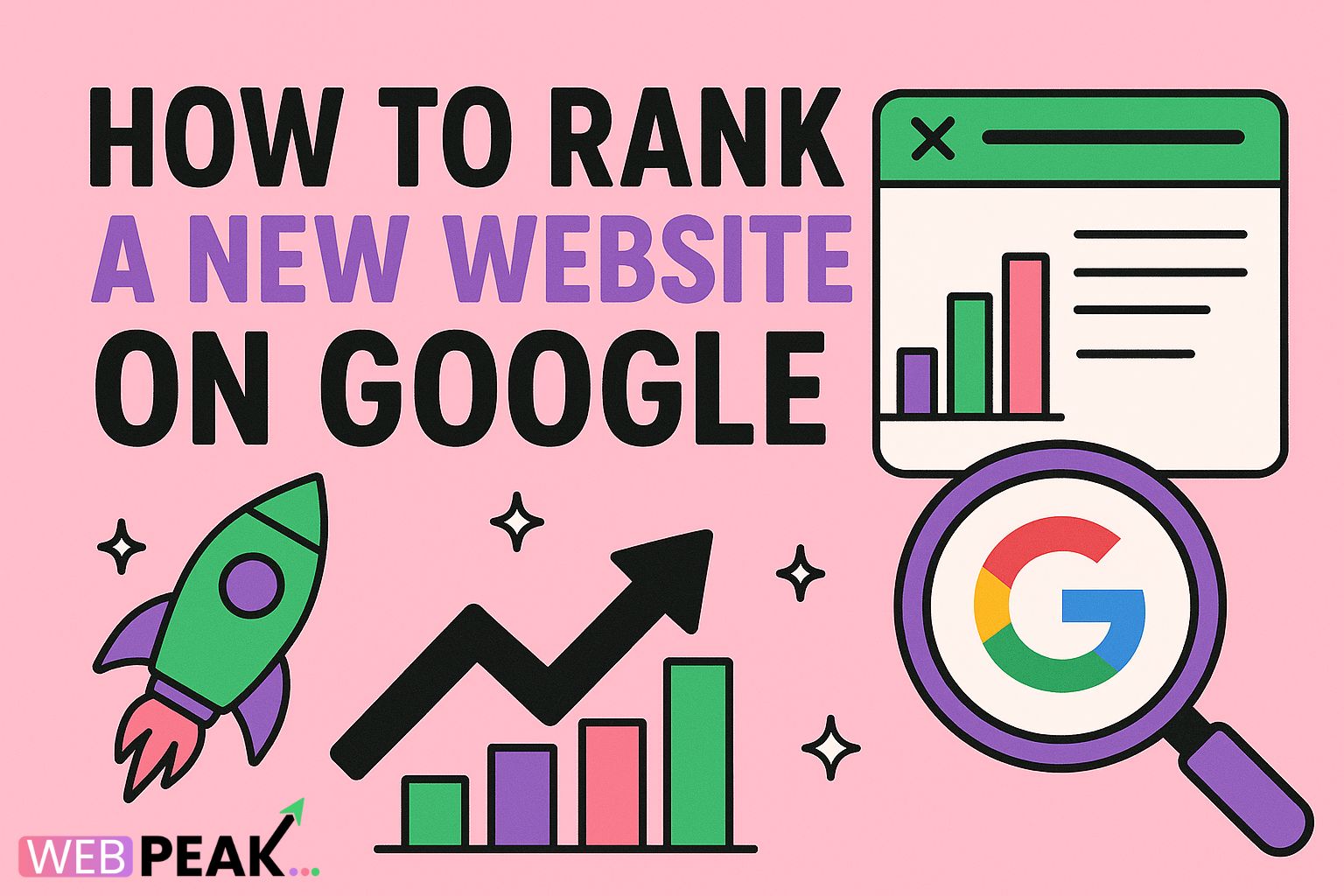How to Rank a New Website on Google: A Complete Step-by-Step Guide
Launching a new website is exciting—but getting it to rank on Google can be challenging, especially with millions of competitors fighting for attention. If you’ve just launched your site, you might be wondering: how to rank a new website on Google quickly and effectively? The good news is that with the right strategy, it’s absolutely possible. In this guide, we’ll break down a complete SEO roadmap to help your new website gain visibility, attract traffic, and establish authority in your niche.
1. Understand How Google Rankings Work
Before you jump into optimization, it’s crucial to understand how Google’s algorithm determines rankings. Google uses hundreds of ranking factors—such as content quality, backlinks, site speed, and user experience—to decide which pages deserve to appear at the top. The main goal is to provide users with the most relevant and trustworthy results.
For a new website, Google takes some time (often called the “sandbox period”) to evaluate your content, crawl your pages, and establish trust. During this time, consistent optimization and high-quality content creation are key to building credibility.
2. Conduct In-Depth Keyword Research
Keyword research is the foundation of every SEO strategy. You need to know what terms your potential audience is searching for and how competitive those terms are. Start by focusing on long-tail keywords—phrases with 3–5 words that are less competitive but highly targeted.
Actionable Steps:
- Use tools like Google Keyword Planner, Ahrefs, or Ubersuggest to find keyword ideas.
- Analyze competitors’ top-ranking pages to identify keyword gaps.
- Group keywords by intent—informational, transactional, or navigational.
- Focus on long-tail keywords like “how to rank a new website on Google fast” or “SEO tips for new websites.”
By targeting specific long-tail keywords, you’ll face less competition and attract visitors who are genuinely interested in your content or services.
3. Optimize Your On-Page SEO
On-page SEO helps Google understand what your page is about. It involves optimizing titles, meta descriptions, headings, and content. Since your site is new, it’s essential to get the basics right from the start.
Checklist for On-Page SEO:
- Title Tag: Include your primary keyword naturally (e.g., “How to Rank a New Website on Google | Complete SEO Guide”).
- Meta Description: Summarize your page in 150–170 characters and make it compelling for clicks.
- Headings (H1, H2, H3): Use your main keyword in the H1 tag and related keywords in subheadings.
- URL Structure: Keep URLs short and descriptive (e.g., yourdomain.com/rank-new-website-google).
- Internal Linking: Link to other relevant pages to improve site structure and keep users engaged.
- Keyword Placement: Include your main keyword in the first 100 words, headings, and conclusion.
4. Create High-Quality, Original Content
Google rewards websites that consistently publish valuable, informative, and original content. High-quality content not only attracts visitors but also keeps them engaged—reducing bounce rates and improving dwell time, which are positive ranking signals.
Content Creation Tips:
- Write comprehensive, well-researched articles that cover topics in-depth.
- Use bullet points, visuals, and short paragraphs to improve readability.
- Incorporate relevant keywords naturally—avoid keyword stuffing.
- Add internal and external links to credible sources.
- Use multimedia (images, infographics, videos) to enhance engagement.
Remember: consistency is key. Publishing high-value blog posts regularly helps establish authority in your niche and signals Google that your site is active and trustworthy.
5. Optimize for Technical SEO
Technical SEO ensures that your website is easy for search engines to crawl, index, and understand. A technically sound website improves both user experience and ranking potential.
Technical SEO Checklist:
- Submit your website to Google Search Console and Bing Webmaster Tools.
- Create and submit an XML sitemap.
- Ensure your website is mobile-friendly (use Google’s Mobile-Friendly Test).
- Improve page speed using tools like Google PageSpeed Insights.
- Fix crawl errors, broken links, and duplicate content issues.
- Enable HTTPS for security.
- Use a clean, SEO-friendly URL structure.
6. Build a Strong Backlink Profile
Backlinks are one of Google’s most important ranking factors. When reputable websites link to your content, it signals that your site is trustworthy and authoritative. However, focus on quality over quantity—spammy backlinks can harm your SEO instead of helping it.
Link-Building Strategies for New Websites:
- Guest post on reputable blogs in your niche.
- Submit your site to relevant directories and local listings.
- Use the “Skyscraper Technique” — improve existing popular content and reach out to websites linking to the old version.
- Engage in online communities, forums, and Q&A platforms to share your content.
- Build relationships with influencers and industry experts for mentions and links.
7. Optimize for Local SEO (If Applicable)
If your business serves a specific geographic area, local SEO can help you appear in “near me” searches. This is crucial for new businesses targeting local customers.
Local SEO Essentials:
- Set up and optimize your Google Business Profile.
- Use consistent NAP (Name, Address, Phone) information across the web.
- Encourage customers to leave reviews on Google and local directories.
- Include location-specific keywords in your content and metadata.
- Add schema markup for local businesses.
8. Focus on User Experience (UX) and Engagement
Google increasingly prioritizes user experience signals like time on page, bounce rate, and Core Web Vitals. A site that loads quickly, is easy to navigate, and provides valuable content will naturally rank higher.
Improve UX by:
- Using a clean, mobile-responsive design.
- Keeping navigation intuitive and easy to follow.
- Reducing intrusive pop-ups and unnecessary redirects.
- Adding CTAs (Calls to Action) that guide visitors effectively.
- Ensuring accessibility for all users, including those with disabilities.
9. Promote Your Content on Multiple Platforms
SEO doesn’t work in isolation. Sharing your content on social media, forums, and niche communities helps drive traffic, increase visibility, and attract potential backlinks. The more engagement your content receives, the more likely it is to be noticed by Google.
Promotion Tactics:
- Share new posts on LinkedIn, Twitter, Facebook, and Reddit.
- Use email newsletters to keep your audience updated.
- Collaborate with influencers or industry leaders.
- Repurpose blog posts into videos, infographics, or podcasts for wider reach.
10. Track, Analyze, and Improve
SEO is a continuous process. Tracking your website’s performance allows you to identify what’s working and what needs improvement. Regularly analyze your traffic sources, top-performing keywords, and conversion rates.
Tools to Use:
- Google Analytics: Track visitor behavior and traffic trends.
- Google Search Console: Monitor indexing, keyword rankings, and click-through rates.
- Ahrefs / SEMrush: Analyze backlinks, competitors, and keyword performance.
- Hotjar: Understand how users interact with your site via heatmaps.
Keep refining your strategy based on data insights. Update old content, fix underperforming pages, and double down on what’s bringing results.
11. Be Patient and Consistent
Ranking a new website on Google doesn’t happen overnight. It can take several months to see significant results. However, with consistent effort, regular content updates, and a focus on user value, your website will gradually climb the rankings and gain organic visibility.
12. Partner with SEO Experts
If SEO feels overwhelming or you want faster, data-driven results, consider partnering with professionals. WEBPEAK is a full-service digital marketing company that specializes in Web Development, Digital Marketing, and SEO services. With expert guidance, you can build a strong foundation and accelerate your website’s growth effectively.
Frequently Asked Questions (FAQ)
1. How long does it take for a new website to rank on Google?
Typically, it takes 3–6 months for a new website to start ranking for competitive keywords. The timeframe depends on your niche, competition, and SEO efforts.
2. Do backlinks really help new websites rank?
Yes, backlinks are a major ranking factor. Quality backlinks from authoritative websites signal trust to Google and can significantly improve your rankings.
3. How often should I post content to improve rankings?
Posting consistently—such as once or twice per week—helps build authority. Focus on quality and relevance rather than just frequency.
4. Can I rank a website without backlinks?
While it’s possible to rank for low-competition keywords without backlinks, building links is essential for long-term success in competitive niches.
5. What are the most common SEO mistakes to avoid?
Common SEO mistakes include keyword stuffing, ignoring mobile optimization, duplicate content, poor site speed, and lack of analytics tracking.
Conclusion
Ranking a new website on Google takes time, strategy, and persistence—but it’s absolutely achievable. Start with strong on-page SEO, create valuable content, build quality backlinks, and continuously optimize your website. Over time, your efforts will pay off with higher rankings, increased traffic, and stronger brand visibility.
Remember, SEO is not a one-time task but an ongoing process. Keep learning, testing, and improving—your website’s success on Google will follow.





